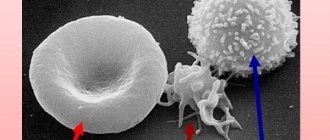A gynecological smear allows you to identify a whole list of diseases of the reproductive system. With its help, the presence of pathogenic microbes, blood elements, epithelial cells and other indicators in the vagina is determined. The number of leukocytes in a smear allows you to identify the presence of infectious and inflammatory diseases, as well as determine the severity of their course.
Now let's look at this in more detail.
The role of cells in the body
The process of destruction of foreign and dangerous elements by leukocytes is called phagocytosis. They capture and absorb “enemies”, then die themselves.
What are leukocytes in a smear in women?
Their main functions:
- Production of antibodies to fight external and internal “enemies”.
- Normalization of metabolic processes and supply of tissues with necessary enzymes and substances.
- Cleansing the body - eliminating pathogens and dead leukocytes.
Flora and cytology - what is their difference?
A flora smear for microscopic examination is taken from the cervix, urethra, vagina or rectum using a special spatula or spatula. Such instruments are used to take secretions that accumulate in the lumen of the above organs without damaging their mucous membrane. If the culture is taken from the vagina, a special speculum is also used.
Important! If a smear is taken from a girl who has not previously had sexual intercourse, a speculum cannot be used during the analysis, since it can damage the hymen.
Interpretation of a gynecological smear for flora in women is carried out in the laboratory. The resulting material is applied to glass, stained with dyes, dried and examined using a microscope. While studying the analysis, the laboratory technician evaluates the amount of mucus, leukocytes and microorganisms. Such a study also helps to detect inflammatory processes.
Cytomorphological examination of cultures is carried out to identify atypical cells that signal problems with the cervix (dysplasia, cancer, etc.). More attention is paid to the epithelium and its cells. Such a smear is taken from the vagina (with a spatula) or from the cervical canal (with a brush).
The result and accuracy of both types of studies depend on the woman’s proper preparation for the tests.
The presence and norms of leukocytes in the blood of children and the urine of pregnant women is an important diagnostic indicator.
Normal, why indicators may be increased
An increase in leukocytes in a smear in women is a sign of an inflammatory process in the body .
You can find out their level by taking tests:
- flora smear;
- blood analysis;
- Analysis of urine.
Women are most often prescribed a smear test for flora.
This study allows you to identify diseases of the urinary canal, kidneys or bladder; recognize the inflammatory process in the urogenital area.
Material for research is taken:
- from the vaginal wall;
- from the mucous surface of the cervix;
- from the mucous membrane of the urethra.
Normal levels of immune cells in a smear:
- from the vagina - no more than 10;
- from the urethra - no more than 5;
- from the uterine cervix - no more than 15.
Table of the norm of leukocytes in a smear in women and other analysis indicators:
During the study, it is necessary to take into account the following features:
- The number of white blood cells (leukocytes) increases after sexual intercourse; elevated levels last for 24 hours after the act.
- Increased levels are observed during the installation of an intrauterine contraceptive device.
- Microtraumas of the vaginal walls also increase the indicators.
The main reasons for an increase in the number of leukocytes in a smear in women are:
- Sexual infections transmitted directly during sexual intercourse (STIs):
- Gonorrhea.
- Chlamydia.
- Ureaplasma.
- Syphilis.
- Trichomoniasis.
- Mycoplasma.
- Papillomaviruses.
- HIV.
- Candidiasis.
- Cytomegalovirus.
- Actinomycetes.
- Genital herpes.
- Bacterial vaginosis. This disease is better known as vaginal dysbiosis. Occurs when the number of pathogenic microorganisms in the vaginal flora increases.
Prerequisites for the development of the disease are hormonal disorders, decreased local immunity, or the use of vaginal suppositories.
- Allergic reaction to gels and lubricants for intimate hygiene or douching products.
- Oncological diseases of the reproductive system.
An increased content of white immune cells in a smear indicates the presence of the following diseases:
- Colpitis is an inflammatory process of the vaginal mucous tissues.
- Cervicitis is an inflammatory process of the cervical canal.
- Endometritis is an inflammatory process of the mucous surface of the uterus.
- Adnexitis is an inflammatory process of the ovaries and fallopian tubes.
- Urethritis is an inflammatory process of the urethra.
- Dysbacteriosis of the intestines or vagina.
- Oncology of the reproductive system.
Note: the reasons for an increased level of leukocytes in a smear in women are prolonged stress or depression.
What contributes to the increase?
Firstly, these are pathological processes in the organs of the genitourinary system.
- endometritis;
- colpitis;
- urethritis;
- oncological diseases;
- vaginosis;
- cervicitis;
- urethritis;
- infections that are sexually transmitted.
There are other reasons that are indirectly related to the genitals:
- hormonal imbalance;
- intestinal dysbiosis;
- inflammatory diseases of other internal organs and systems;
- medications.
A lot of leukocytes in a smear may be due to stress. Strong emotional stress is perceived by the body as a threat. Over time, their levels return to normal. Such indicators may also occur in women who are sexually active. The higher the score, the more serious the disease. In pregnant women, this picture indicates the resumption of “dormant infections.” The weakening of the immune system became the impetus for the resumption.
Thus, leukocytes in a smear may be elevated due to various factors. Relying only on this indicator in the analysis, it is difficult to establish an accurate diagnosis and prescribe appropriate treatment.
Symptoms of increase
Signs indicating an increase in the level of leukocytes and the development of an inflammatory process in the urinary system:
- painful urination;
- the appearance of a false urge to urinate;
- discharge of an unusual nature;
- pungent odor of genital discharge;
- burning and itching sensation inside the genitals;
- failure of the menstrual cycle;
- problems with conception;
- discomfort during sexual intercourse.
The manifestation of such symptoms is a reason to take a smear on the flora and check the condition.
The inflammatory process can occur without pronounced symptoms. It is important to listen to the slightest deviations.
Find out what the norm of ESR in the blood of women should be! Study the table of indicators for ladies of different ages.
You will learn about the causes of high bilirubin in the blood in women, and what diseases can be discussed with elevated levels in this text.
What to do if a woman's platelet count is below normal? We will tell you about the functions of these cells and the features of treating abnormalities here.
First degree: clean vagina
This test is taken at every visit to the doctor. It is worth noting that the study is carried out quite simply and quickly, but nevertheless it can say a lot about the state of the female reproductive system. That is why gynecologists primarily prescribe this test.
After receiving the result, you can make a preliminary conclusion. Most often, doctors classify the fairer sex according to the degree of vaginal cleanliness. This classification directly depends on the number of leukocytes and other impurities. So, if leukocytes are found in a smear, is this normal or pathological?
First degree
In this case, the result of the analysis is the following data. Leukocytes are detected in the amount of several units in the field of view. The microflora is represented by beneficial bacteria. There are no cocci, pathological mucus and Trichomonas. The conclusion will indicate: smear analysis (leukocytes) is “normal”.
Second degree
There are also single cells of white bodies in the field of view. However, beneficial microflora is represented along with cocci and yeast fungi. Usually, in the absence of complaints of itching and unusual discharge, a woman is considered absolutely healthy. However, if there are unpleasant symptoms, then minor treatment is required. If such microflora is detected in the expectant mother, then she is prescribed therapy without certain symptoms.
Third degree
In this case, the result of the analysis may be the following data: the number of leukocytes exceeds the norm (more than 30 cells in the field of view), cocci, yeast and other pathogens are present. This result is always considered a deviation from the norm. The woman is prescribed treatment.
Fourth degree
This is the very last step. In this analysis, a large number of leukocytes are present. Beneficial microflora is depleted, pathogenic bacteria and microorganisms are revealed. If such a result is obtained, additional diagnostics are necessary, after which the woman is prescribed appropriate treatment.
In this case, leukocytes in the smear (the norm for women is 1-3 per field of view) may be completely absent. Sometimes the laboratory technician notes the presence of single white bodies. This suggests that there is no inflammatory process in the examined areas. In addition to leukocytes, lactobacilli and other microorganisms are present in the vagina.
A large number in pregnant women
During pregnancy, a smear test for flora is required, both during registration and before birth.
Indicators are within the acceptable norm - 10-20 units in the observation field. And an increased amount indicates the development of inflammation.
Often during pregnancy, many diseases that did not manifest their presence before conception become aggravated.
There is a change in hormonal levels , immune defense decreases, and often pregnant women develop thrush or candidiasis. If an elevated level of white blood cells is detected, it is necessary to undergo an examination to determine the exact cause of the inflammatory or infectious process.
The causes of elevated white blood cells in a smear in women may include:
- Sexually transmitted diseases (ureaplasmosis, syphilis, gonorrhea and others).
- Thrush.
- Vaginosis.
- Colpitis.
Any inflammatory or infectious process poses a serious danger during pregnancy, so treatment is necessary.
Doctors often prescribe the drug to strengthen local immunity:
- Echinacea.
- Immunal.
- Eleutherococcus.
- Ginseng.
For the treatment of vaginosis the following is prescribed:
- Bifidumbacterin.
- Lactovit.
- Lactofiltrum.
Norm of leukocytes in a smear in women (table)
Once the smear is taken, it will be sent to the laboratory for examination. Here, under a microscope, the number of leukocytes in the field of view will be counted. Normally, the value of the indicator should not exceed 15. In a healthy woman, white blood cells are always present in the vagina in small quantities. If an infection appears, they recognize foreign cells and begin an active fight. This leads to an increase in the number of white blood cells.
A smear on the flora can be obtained from one of three points - the urethra, vagina or cervix. Depending on where the biomaterial was taken from, the leukocyte rate may vary. It amounts to:
- 0-10 if a smear was taken from the urethra;
- 0-15 if the smear was taken from the vagina;
- 0-30 if the smear was taken from the cervix.
In order to determine the woman’s condition, the doctor will also pay attention to the presence of other microorganisms in the smear. So, it should not contain chlamydia, gardnerella, yeast-like fungi, gonococci, atypical cells and trichomonas. The result of the analysis can be found out very quickly. Usually the result of the study is known on the day of taking a smear. Sometimes the deadline is shifted by two or three days.
| Norm of leukocytes in a smear | ||
| Vagina | Cervix | Urethra |
| Up to 15 | Up to 30 | To 10 |
During pregnancy
During pregnancy, changes occur in the functioning of the organs and systems of the female body. This happens because the hormonal balance changes. There is an increased load on the kidneys. The microflora of the vagina also undergoes changes.
During pregnancy, a smear is taken from the woman several times. Initially, the action is carried out upon registration. Normally, the number of leukocytes in pregnant women is 15-20. Exceeding the value of the indicator may indicate an acute pathological process or the course of latent infections that have worsened as a result of bearing a child. Most often, this phenomenon is provoked by sexually transmitted diseases or thrush. If leukocytes increase, additional diagnostic tests are prescribed, on the basis of which treatment is selected.
Before and after menstruation
The period before and after menstruation is considered the most favorable for taking a smear on the flora. During this period of time, a change in the number of white blood cells may be observed. Experts associate this phenomenon with the presence of hidden STIs in the body. Only in one percent of cases such changes are natural. The number of leukocytes before menstruation can be 35-40 if the smear was taken from the vagina, up to 10 if the sample was taken from the urethra, up to 30 if the material was taken from the cervix.
If a smear test is performed immediately after menstruation, a significant deviation of white blood cells from the standard is observed. The difference can be 1-3 units. This is due to the fact that in the first 2-3 days after menstruation, the uterus has not yet completely cleared itself.
If a woman does not adhere to the rules of personal hygiene during menstruation or uses tampons incorrectly, the number of leukocytes can increase significantly. However, the value usually returns to normal within a few days if hygiene is restored to normal.
High content after childbirth
Leukocytes instantly react to the slightest deviations or changes in the functioning of the body. Therefore, their levels often increase for physiological reasons. This also includes the postpartum period.
During childbirth, a woman loses a lot of blood.
To prevent complications, immune white cells are prepared in advance for such a situation and accumulate in large numbers in the uterine area.
This is associated with an increase in the number of their indicators in a smear after childbirth.
Their number increases during the onset of labor and during the recovery period. The indicators return to normal 4-5 days after birth.
If the elevated level of immune cells lasts more than 5 days and has serious deviations from the norm, this indicates the development of complications after childbirth and inflammation in the uterine cavity, kidneys or urinary system.
In such cases, you should immediately consult a doctor.
What are leukocytes?
White blood cells are called leukocytes. This group includes a whole list of cells that perform a protective function. So, if pathogenic microorganisms penetrate the human genitourinary tract, leukocytes will also enter from the bloodstream through the capillary wall. When foreign flora is encountered, phagocytosis begins. During it, leukocytes neutralize pathogenic microorganisms. If there are too many foreign bacteria, the white blood cells die. As a result, local inflammation appears. If the infection is not stopped, the number of dead leukocytes increases. As a result, pus is formed.
Normally, leukocytes may be present in a smear for flora. However, their number should not be too large. A slight excess of the norm may occur for physiological reasons. If there is a significant deviation in the number of leukocytes in the smear from the norm, and there are also signs of phagocytosis, this indicates the presence of an infection that could be provoked by pathogens of various types.
Diagnostics and medical assistance
If an increased level of leukocytes is detected in the smear, you should consult a doctor:
- Gynecologist.
- Dermatovenerologist.
- Infectious disease specialist.
The doctor chooses the treatment method based on laboratory tests. To establish an accurate diagnosis, additional diagnostics are prescribed.
The following types of diagnostic procedures are most often prescribed:
- sowing on flora;
- flora smear;
- ELISA (enzyme-linked immunosorbent assay);
- test for antibodies in the blood;
- biopsy;
- PCR (polymerase chain reaction);
- CBC (complete blood count);
- OAM (general urinalysis);
- Ultrasound of the abdominal cavity.
Find out on our website what the norm of the hormone prolactin should be in women! What is it responsible for, and why can its level fluctuate?
In what cases can androstenedione be elevated in women: we will talk about the consequences of high levels of this hormone in our special review.
What does an elevated TSH level mean in women, and in what cases should you consult an endocrinologist, read here:.
Purpose of a smear for flora
A flora smear is so called because during diagnosis it becomes clear which flora (environment) currently predominates in the uterus - pathogenic or normal. Indicators for collecting analysis are a routine examination by a specialist, specific complaints of the patient: burning sensation, pain in the genitals, abdominal pain, poor urination. The study is also carried out when planning conception, after a course of antibiotics, directly during pregnancy, and after childbirth. In the first two trimesters, scrapings for flora are examined at least 3 times, and if there are complications or complaints from the patient, even more often.
If a lot of leukocytes are detected in the smear, certain therapy will be prescribed. What does taking a test mean, how to lower the level of leukocytes, how to treat this complication - let’s look at it in more detail.
Preparing for analysis
In order for the study to show the most truthful result, the following preparatory steps must be taken:
- do not have sexual intercourse 2 days before scraping;
- do not use contraceptives for 2 days;
- try to refrain from urinating 3 hours before taking the test;
- do not douche for 2 days;
- in the evening before taking the test, wash only with water, without using cosmetics (they affect the acidic environment of the genital tract).
Important! Scraping is not performed during menstruation - blood in the vagina, which is an antimicrobial agent, changes the composition of the scraping, and the diagnosis will show an incorrect result.
A smear is sometimes given involuntarily and without prior preparation - in case of emergency hospitalization. In this case, the analysis is taken, if possible, in the morning, before any gynecological procedures are performed.
Smear collection procedure
Please note: in women aged 18 to 45 years, the leukocyte rate should not exceed 6-8 units. If the leukocytes in the smear are elevated, additional manipulations will be carried out to determine the reason for this.
A smear is taken using special sterile gynecological instruments. The analysis is taken from the urinary system with a special loop, and from the back wall of the vagina - with a clean swab. The scraping is directly applied to the glass and allowed to dry. In general, this operation is painless and short-lived.
The smear is then sent to laboratory technicians for review and diagnosis. The smears are colorless, so they are stained with special dyes - this makes them easier to study. Afterwards, leukocytes and other bacteria are counted, which for convenience are also painted in different colors. The readings are deciphered by a gynecologist. Please note: during pregnancy, white blood cells can increase to 20, this is considered normal.
Often, a smear does not determine that the cause of the complication is an infectious disease. The fact is that this analysis by itself is not able to recognize the infection due to the narrow limitations of the study of certain microbes. Therefore, the gynecologist will definitely prescribe special tests to determine the cause of the complication.
Drug treatment
As noted, an increase in white immune cells can occur due to an inflammatory or infectious disease. Treatment for inflammation or infection is varied.
Treatment of the inflammatory process is carried out according to the following scheme:
- Use of antiseptics. The vagina is regularly washed with antiseptics “Miramistin”, “Chlorhexidine”, “Potassium permanganate”.
- Antibacterial drugs are used. "Genferon", "Pimafucin", "Terzhinan", "Viferon" are prescribed.
- For the treatment of candidiasis - Fluconazole and Flucostat.
Treatment of the infectious process is carried out according to the following scheme:
- Intravenous use of antibacterial agents: Ornidazole, Metronidazole and Tsiprinol.
- Prescription of drugs for the prevention of vaginal dysbiosis: “Bifidumbacterin”, “Laktovit” and “Lactofiltrum”.
Note: it is forbidden to self-medicate using antibacterial agents. They are prescribed only by a competent doctor, taking into account the severity of the disease and the patient’s condition.
Interpretation of test values
Since smears are taken from different areas of the woman’s reproductive system, they have their own name:
- C - cervical area;
- V - vaginal mucosa;
- U - cervical canal.
Table of leukocyte indicators in the cervix, vagina and cervical canal:
An increase in leukocytes indicates the development of a pathological process in the woman’s reproductive system. During pregnancy, the number of leukocytes may be slightly elevated due to a decrease in the body's protective functions. However, the indicator should not exceed more than three units ideally. The indicator can also increase in women after 50 years of age due to hormonal changes.
Important! Many doctors consider an increase of 5 units to be natural and acceptable. However, an increase in the number of leukocytes by 20 units indicates the development of a pathological process.
The epithelium may deviate in its value, and its absence indicates estrogen deficiency - a hormonal pathology. An overestimated indicator indicates an inflammatory process.
Candida, Trichomonas, gonococci and key cells should not be present in the material - this indicates the development of viral/infectious processes.
Mucus is produced in the cervix and vaginal environment. Excessive mucus secretion is a sign of pathological abnormalities.
Other flora include lactobacilli and gram-positive bacilli, a moderate amount of which should be present in healthy flora. A decrease in indicators indicates the risk of developing pathology due to the inactivity of local immunity.
If the material contains E. coli, then there is a risk of bacterial vaginosis. The stick can get in due to poor personal hygiene and when wearing thongs.
Many people believe that only sexually active women can have a large number of white blood cells in the material. However, pathological changes can also occur in virgins, for example, due to visiting a sauna or hypothermia. The reasons may be different, so all the nuances can be clarified only after a laboratory examination of the biomaterial.
How to treat with traditional methods
Traditional methods involve the use of homemade herbal decoctions for douching and oral administration.
They can be prepared according to the following recipes:
- Pour one dessert spoon of dry chamomile herb (can be replaced with nettle, calendula, St. John's wort) into glasses of boiled water. Bring to a boil over low heat, remove from heat, leave for half an hour. Strain. Use for vaginal douching.
- You can douche with soda. To prepare the solution, use half a small spoon of baking soda. It is diluted with a glass of warm water.
- A decoction of St. John's wort for oral administration is useful. One dessert spoon of herb is poured into a glass of water and boiled for a quarter of an hour. Strain, take 1/4 cup three times a day.
- You can prepare a medicinal bath from a decoction of dry laurel leaves. 20 g of herb is diluted in a full bucket of water. A sitz bath is taken in this decoction.
Preparation for the procedure
The analysis is taken in the first days after the end of menstruation or before its onset, however, in emergency cases, scraping is done at any time. What rules must be followed when preparing? A woman should:
- refuse intimate contacts three days before taking a sample;
- stop taking any medications a week before the tests - including diuretics;
- stop using hygiene products for washing the genitals two days in advance - you should wash only with warm water;
- refrain from urinating for three hours before taking the sample.
You should also not douche a couple of days before taking a smear. When visiting a doctor, you need to wear fresh, pure cotton underwear; your genitals should be washed with warm water without hygiene products. In case of morning bowel movements, you should wipe the perineum with an antibacterial wipe.
The tests are ready in about 2-3 days. In paid clinics, results can be obtained within a few hours. If tests reveal an increased number of white blood cells, a diagnosis for a hidden disease is prescribed.
Norm
The norm of neutrophil leukocytes in the blood varies according to age criteria, but there are no differences according to gender.
The norm table is presented below.
| Age | Average rate | |
| Band neutrophils | Segmented neutrophils | |
| Newborns/infants | from 1 to 5% | from 27 to 55%. |
| Children under 5 years of age | from 1 to 5% | from 20 to 55% |
| Children under 15 years of age | from 1 to 4% | from 40 to 60% |
| Adults | General indicator from 45 to 70% | |
In order to determine the amount of neutrophils in the blood, doctors prescribe a detailed blood test.
Consequences of inflammatory diseases
Expert opinion
Kovaleva Elena Anatolyevna
Doctor-Laboratory Assistant. 14 years of experience in clinical diagnostic services.
An increase in the level of leukocytes is a signal of the presence of inflammatory and infectious diseases, many of which may be asymptomatic. Identification of the cause and its elimination must be carried out immediately. Otherwise, a woman puts her health at great risk.
- Infertility;
- Ectopic pregnancy;
- Complications during pregnancy;
- Endometriosis;
- Oncology;
- Menstrual irregularities;
- Adhesive processes leading to infertility;
- Uterine fibroids.
For the prevention and timely detection of diseases of the reproductive system, a woman should undergo a gynecological examination every 6 months.
Kinds
Neutrophil granulocytes in the blood are divided into two types according to the shape of the nucleus:
- Band neutrophil leukocytes - have the shape of a horseshoe-shaped nucleus, are considered immature or young neutrophils.
- Segmented neutrophil granulocytes are a mature form of neutrophil with a segmented nucleus. They are also called “heroic” because when they encounter microbes they absorb them and die.
In order to determine the condition of the human body, experts compare the percentage of mature and young neutrophils. It is known that in newborn children there is an increased number of band neutrophils, but later such cells are replaced by segmented representatives. And after three weeks of the child’s life, the balance between mature and young cells is equalized.
Indications for analysis
If the patient has no complaints about her health, there are certain indications for prescribing the study:
- preventive examination
- pregnancy confirmation and registration
- stump of the cervix of the reproductive organ after surgical treatment
- dysplasia
A specialist may order a study in the following situations:
- specific vaginal discharge
- discomfort during urination
- severe pain in the lower abdomen
- change in consistency and color of genital discharge
- itching and burning in the groin area
- discomfort during sexual intercourse
- menstrual irregularities
- long-term use of antibacterial drugs
- first trimester of pregnancy
- long-term treatment with hormones
A smear on the flora is always carried out after recovery from gynecological pathologies and upon pregnancy
Preparing for the study
To obtain accurate and reliable research results, certain rules must be followed. Before the study it is recommended:
- within two days before the flora test, abstain from sexual intercourse
- Do not use vaginal suppositories or various creams for 24 hours before the test
- The last urination before going to the doctor should be several hours before the procedure
- after completion of antibacterial treatment, at least 10-14 days should pass
- It is not allowed to carry out the douching procedure two days before the analysis
- On the day of the study, you cannot carry out the washing procedure using any intimate hygiene products.
A smear on the flora is not recommended on the day of menstruation. It is best to visit a doctor in the first few days after your period or before it starts.
This is interesting: Ultrasound of the breast: features of the procedure and interpretation of the results
Features of the procedure
A smear on the flora is performed in the following sequence:
- the patient is positioned in a gynecological chair
- a specialist inserts gynecological speculum into the vagina and exposes the cervix
- mucus is collected from the cervix of the reproductive organ, vagina, urethra for flora
- the material is applied in a thin layer to the prepared glass under the symbols: U, C and V
After the glasses have dried, they are sent to the laboratory for testing. The material is stained with special dyes, and the doctor examines it under a microscope. During the study, the concentration of white blood cells and other opportunistic and pathogenic bacteria are calculated.
What diseases can cause an increase in leukocytes in the cervix
A change in discharge is considered one of the signals that the level of white blood cells has increased. The secretion from the mucous membranes of the genital organs becomes cheesy and has a not very pleasant smell. Also symptoms are: pain in the pelvic cavity, itching and burning in the genitals, failure of the frequency of menstruation. An increase in the content of leukocytes in the cervix may well mean the existence of disorders in the organs of the genitourinary system, such as inflammation of the cervical canal (cervicitis). If you do not begin to get rid of this problem in time, it will provoke erosion of the cervix, which in the future will cause infertility. During cervicitis, with a high level of white blood cells, the following symptoms are characteristic: frequent pain in the lower abdominal region; discomfort during sexual intercourse; itching in the genitourinary system.
Treatment for neutrophilia
If neutrophilic leukocytes are elevated (from the nose in a smear, for example), you first need to identify the reason why this is happening. This should be done, since there are no direct means that will help reduce neutrophils.
Below is a list of actions to take if neutrophilia (increased number of neutrophils) is observed:
- It is imperative to visit a general practitioner and provide him with test results, as well as tell him about the presence of certain symptoms.
- In order to confirm the accuracy of the tests, you need to take them again, while following all the rules for preparing for diagnosis.
- If neutrophilia is nevertheless confirmed, then the next step will be a complete diagnosis of the body to detect inflammatory diseases.
- After a detailed diagnosis, specialists, in accordance with the disease, prescribe drug therapy:
- antibiotics;
- immunostimulants;
- sedatives;
- corticosteroids;
- cleansing the blood of excess leukocytes.
Features of the neutropenia process
Neutropenia is a condition when neutrophilic white blood cells are low in the blood. It has already been said above that neutrophils react to foreign bodies in the body and in every possible way protect and keep the immune system in order. That is, when neutrophils detect an infection in the body, they form a “block” around the inflammation, thereby creating obstacles to the further spread of foreign agents. The result of such a struggle between neutrophilic leukocytes and infection will be the formation of pus in the wound, inflammatory and intoxication syndrome.
The disease can be hidden if the person initially has neutropenia, but because of this, the infection can spread throughout the body and lead to sepsis. The first clinical manifestations of neutropenia may be:
- stomatitis;
- gingivitis;
- purulent sore throat;
- osteomyelitis;
- abscess;
- sepsis.
Those patients who are susceptible to neutropenia should avoid contact with other sick people, and they are also not recommended to be in a place where there are large crowds of people. Every year it is necessary to carry out planned prevention of seasonal diseases. In addition, microbes that are completely safe for the average person can adversely affect the health of patients with neutropenia.
Functions of leukocytes
A certain number of these cells are invariably present in the blood of a healthy body, however, the value of this indicator may vary depending on various conditions: time of day, sensitive and physical state of the body, etc. When an infection enters the body, their number increases if the body’s immune system recognizes the threat in a timely manner. In this case, leukocytes produce antibodies to a specific pathogen. Together with it they form an insoluble compound and are excreted from the body. Leukocytes are also necessary for allergies to absorb allergens - non-infectious irritants to which the body can react ambiguously. White blood cells are produced by the bone marrow. In the body, leukocytes are presented in various forms, each of which has a separate function. If the proportion of blood composition is disturbed, a solid systemic disease of the body progresses, in which the blood is unable to perform its functions. This condition requires vigorous medical intervention, since it poses a real threat to life.
Treatment with folk remedies
Just like elevated leukocytes in the blood, it is pointless to treat high leukocytes in a smear, since this is not a disease, but a laboratory indicator. It is necessary to establish a diagnosis, begin to adequately treat the disease, and then the question of how to lower white blood cells in a smear will become irrelevant.
However, in the case where the cause of a significant increase in leukocytes in the smear could not be established, and this level persists for a long time, the gynecologist may suggest the following treatment regimen:
- normalize sleep patterns;
- balance your diet;
- avoid overheating and hypothermia, as well as sudden temperature changes;
- prescribe vitamin complexes and drugs that increase immunity;
- sometimes, cancel (prohibit) taking hormonal contraceptives;
- select medicinal vaginal products for external use - suppositories or suppositories, capsules, tablets, liquids for douching, wash products, creams and gels in applicators, special tampons.
It will also be strongly recommended to reduce the level of psycho-emotional stress and avoid stressful situations.
How to reduce the number of leukocytes on a smear? To do this, it is necessary to establish the type of disease that caused the increase in the number of blood cells.
Knowing the causes of elevated leukocytes in a smear in women, the doctor will be able to prescribe the correct comprehensive treatment that will not harm the body of the expectant mother and the fetus.
Having discovered a questionable test result, the gynecologist will once again conduct an examination and take tests. To do this correctly, it is recommended to properly prepare for the procedure:
- complete exclusion of intimacy;
- lack of douching;
- avoiding taking certain types of medications.
If, after taking a repeat test, the results are also unsatisfactory, the patient will be prescribed a comprehensive examination:
- taking contents from the surface of the cervix for bacteriological culture;
- carrying out PCR for the course of latent infections in the body;
- performing an ultrasound scan on the pelvic organs.
Only after this can the disease be treated, which will reduce white blood cells in the vaginal cavity.
The following methods are used to treat inflammatory diseases of the genital organs:
- Vaginal douching with antiseptic agents: miramistin, chlorhexidine, potassium permanganate;
- Antibacterial vaginal suppositories: “Genferon”, “Heksikon”, “Terzhinan”, “Viferon”;
- For candidiasis, the drugs Fluconazole and Flucostat are taken orally.
Treatment of infectious diseases requires intravenous administration of antibacterial drugs: Ornidazole, Tsiprinol, Metronidazole. Local vaginal douching with antiseptics is prescribed together. Upon completion of treatment, a course of restorative therapy is carried out, aimed at the vaginal population with beneficial bacteria, using eubiotics: “Bifidumbacterin”, “Lactobacterin”, Vagilak” and others.
Important: all medications should be taken strictly as prescribed by your doctor. Self-medication with antibiotics carries a lot of side effects.
For inflammatory diseases, it is recommended to douche daily with the following decoctions:
- A tablespoon of chamomile, calendula, and stinging nettle flowers (optional) is poured into a glass of water, brought to a boil, removed from heat and left for half an hour. Before use, decoctions should be strained through a sieve or cheesecloth.
- Pour 6 cloves of chopped garlic into 1.5 liters of hot water, leave to steep overnight, and strain before use.
- Pour 2 cloves of chopped garlic into 2 cups of hot water, add 1.5 tablespoons of apple cider vinegar, stir and strain.
- For thrush: mix 1 dose of dry bifidumbacterin with a teaspoon of warm water, add 1 teaspoon of Vaseline. Soak a tampon with the resulting ointment and insert it into the vagina for 10 hours. Course of treatment: 7 – 10 days.
The collection of biomaterial for research is carried out by a doctor in a special gynecological chair using sterile instruments. After inserting the gynecological speculum, biomaterial is taken from the posterior wall of the vagina (V) for examination using a cytobrush, from the surface of the cervix (C) with an Eyre spatula, and from the urethra (U) with a Volkmann spoon.
The level of leukocytes is determined by microscopy. In the laboratory, a Gram-stained and fixed (killed cells) smear is examined under a microscope to count the number of opportunistic bacteria and white blood cells. In addition, the presence of atypical cells characteristic of cancer pathology is visually determined.
The turnaround time for the analysis depends on the workload of the laboratory, but on average does not exceed 1 day, excluding the day of collection of the biomaterial.
How to prepare?
Preparation for taking biomaterial for research includes the following rules:
- restriction of sexual life for 2-3 days;
- for 2 days, the use of vaginal medications, as well as douching, is excluded;
- 2-3 hours of abstaining from urination;
- At least 2 days must pass from the end of menstruation. The preferred time for research is before the start of menstruation;
- Hygiene procedures are carried out in the evening and exclude the use of soap and gel.
In order to bring the values of white blood cells to normal levels, it is necessary to first establish the cause of their increase. After which the doctor prescribes treatment, which usually consists of a course of antibiotic therapy. It is strictly forbidden to choose antibacterial drugs for treatment on your own. The danger of this is due to 2 reasons:
- ineffectiveness, which will lead to the spread of the pathogen throughout the patient’s body and significantly complicate further treatment;
- large-scale spread of bacterial strains resistant to antibacterial drugs. As a result, they may be immune to any of the known groups of antibiotics.
On the advice of a doctor, it is permissible to use douching with a solution of chamomile, aloe or St. John's wort. However, this method is not independent and should be used in combination with drug therapy.
The lack of positive dynamics in the reduction of white cells in the analysis indicates the need to correct the course of treatment.
How to reduce leukocytes in a smear during pregnancy: treatment
Normalizing the level of leukocytes is directly related to eliminating the problem that caused this condition. Based on the results of assessing the symptoms, as well as the data obtained from additional examinations, the doctor determines the cause of the increased number of leukocytes in the smear during pregnancy and the necessary treatment regimen. It is important to remember that self-prescription of drugs is strictly unacceptable.
Drug treatment of leukocytes in a smear during pregnancy
If a disease is detected, then herbal treatment alone will not be enough. An integrated approach to eliminating the disease includes both local and general therapy.
- Antibacterial therapy is prescribed, but only if there are absolute indications. For example, when gonorrhea, ureaplasma or syphilis are detected, Ceftriaxone, Azithromycin, and Erythromycin often become the drugs of choice.
- Treatment for genital herpes is not always prescribed. But in cases where the doctor sees the feasibility of therapy, Zovirax ointment can be used.
- In cases of candidiasis, treatment with drugs such as Pimafucin, Polygynax, Livarol, Clotrimazole, Terzhinan is possible (the last 3 drugs are prohibited for use in the first trimester of expecting a baby)
- Solutions of potassium permanganate, miramistin, chlorhexidine, and chlorophyllipt can also be used to treat the genitals.
Methods of traditional therapy for leukocytes during pregnancy
If no serious abnormalities are found, the woman can turn to traditional medicine. But even in this case, a preliminary consultation with a doctor is necessary.
- Herbal decoctions will help normalize vaginal microflora. St. John's wort leaves, chamomile, aloe, oak bark or red root are suitable for these purposes. To carry out the procedure, you must prepare a warm sitz bath with a healing decoction. Sage, coltsfoot, and calendula also have a good effect.
- Candles with sea buckthorn oil. Mix 10 g of oil with beeswax. Melt the resulting composition in a water bath, while simultaneously mixing in 3 g of pine resin. Pour the resulting mass into molds (for future suppositories) and cool. Insert 1 suppository vaginally before bedtime.
- It is necessary to improve nutrition by saturating the diet with fermented milk and protein products.
- Until complete healing, abstinence from intimate relationships is recommended.
Do not worry too much if, after the analysis, a large number of leukocytes are found in a smear during pregnancy. Additional tests and examinations will help determine the exact cause of the violations and effectively deal with them.
How to reduce white blood cells
We found out what an increase in leukocytes in tests is. Now it’s worth understanding how to properly carry out comprehensive treatment that will restore the health of the genital organs.
You cannot treat the disease yourself, as this can negatively affect the baby’s condition.
Treatment of the disease directly depends on its nature. Usually, the doctor prescribes antibiotics and special suppositories to patients, which are inserted into the vaginal cavity. These include:
- Terzhinan;
- Polygynax;
- Pimafucin.
Also, treatment of diseases in women, the causes of which are hidden in the development of infection on the genital organs, can be carried out using traditional methods that restore the normal microflora of the vagina. Folk remedies include:
- Oak bark;
- chamomile decoction;
- red root;
- St. John's wort;
- aloe leaves.
Why doesn’t the amount of hazardous substances in a smear decrease? This can happen if the woman has not taken antibiotics, which inhibit the development of microflora harmful to health. It is known that folk recipes cannot completely destroy bacteria, which means that first they need to be destroyed with drugs, and only after that begin to normalize the microflora.
Important! How to “rinse” the vaginal cavity? To do this, you can use a solution of chlorophyllipt (it is used as a treatment strictly according to the doctor’s indications).
The correct tactics for treating the disease will restore the mother’s health and not harm the baby’s condition. The main thing is not to self-medicate, which poses a direct threat to the lives of both.
Conclusion
Thus, to summarize, it is necessary to emphasize:
- compliance with the rules of preparation for taking a smear significantly increases the reliability and accuracy of the results obtained;
- deviation of the criterion from the norm by several units has no diagnostic value, however, a significant excess is a reason for conducting a large-scale examination of the patient;
- in most cases, increased values are observed during the inflammatory process;
- in pregnant women, reference values differ and correspond to higher values, unlike non-pregnant women;
- Independent interpretation of the analysis and diagnosis is not allowed. Treatment is carried out under the supervision of a specialist.











